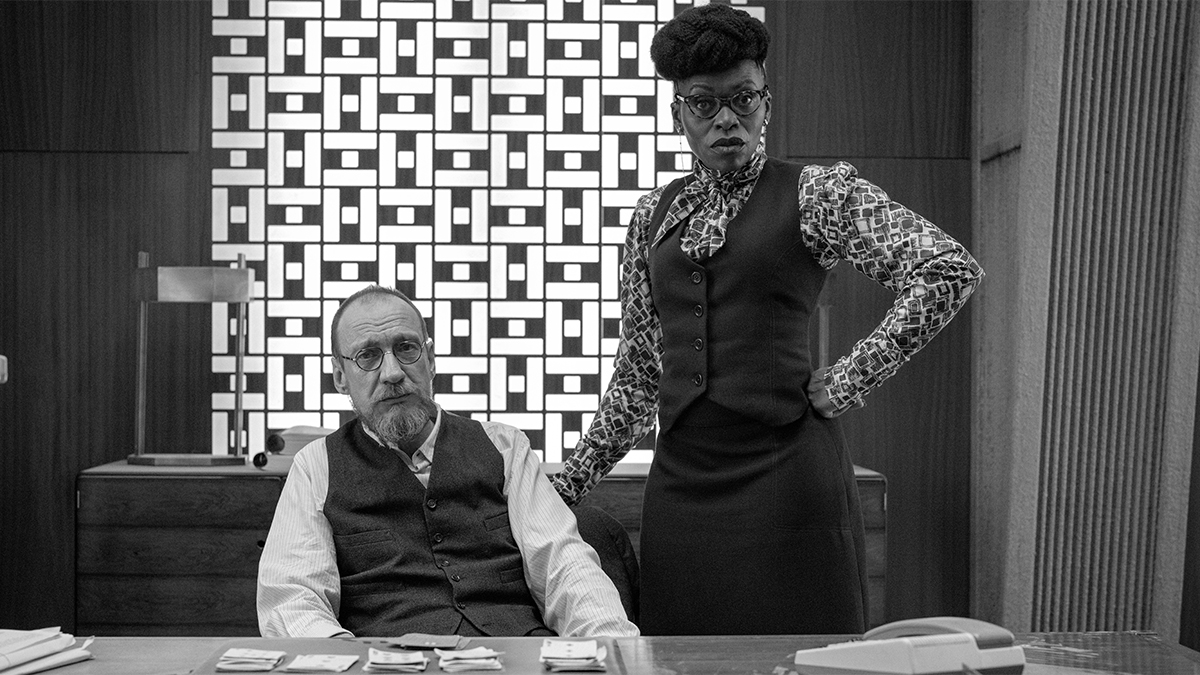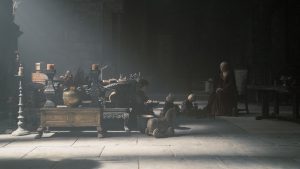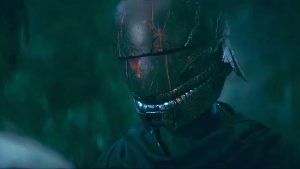
A grown up modern re-telling of a selection of Greek myths, KAOS, created by The End of the F***king World’s Charlie Covell is an absolute blast, particularly if you have a vague working knowledge of the stories it’s based on. KAOS plays with some of the most popular myths, making smart changes here and there, tweaking to give characters more depth and agency and keep Greek-geek audience members on their toes. There are references to all sorts of myths here but there are a handful that provide the backbone of the series. Let’s delve into the bits KAOS sticks to and what changes are made.
The Family Of The Gods
KAOS sticks to the family structure of the gods in general, but it’s worth reminding ourselves of exactly what that is – Prometheus explains it but it’s bonkers enough to need repeating.
Zeus, Hera, Poseidon and Hades are all siblings. Their father Cronus had overthrown and castrated his own father Uranus and was prophesied to be defeated by one of his kids (which also includes Demeter and Hestia). As soon as they were born Cronus ate his children, with the exception of Zeus – his mother Rhea replaced the baby with a stone and hid the baby Zeus until he grew old enough to overthrow and defeat Cronus.
Zeus is indeed the father of Dionysus as well as many other gods and demi-gods. This includes Persephone, whose mother is Demeter, Zeus’s sister. Yep, that’s right, so Zeus is the father of his own niece who is now married to Zeus’s brother, Hades, which KAOS does not mention. A good choice, since this most complicated and incestuous heritage would have taken a lot of air time.
Orpheus and Eurydice
One of the main storylines is the myth of the two lovers, and Orpheus’s journey to the underworld with the hopes of retrieving Eurydice. It’s a popular story and has certain variations. KAOS’ version makes further smart changes.
As in KAOS, in the original story Orpheus is a beloved musician – he’s a talented singer and lyre player. When Eurydice is killed by a snake bite, Orpheus plays sad songs, so the gods are aware of his grief. Orpheus heads to the underworld to plead with Hades and Persephone to allow Eurydice to return to the land of the living.
In the myth, Hades takes pity on Orpheus and tells him he can return to the land of the living with Eurydice if he sticks to a single rule. The rule is that he must leave, trusting that she will follow, and not look back. Sadly, unable to hear Eurydice’s footsteps Orpheus begins to believe he has been tricked. He looks back only to see Eurydice as a shade, whisked back to the underworld for good (and no, he’s not allowed another go).
In KAOS Eurydice (Aurora Perrineau) is hit by a truck after saying she defies the gods. In this version Eurydice “Riddy” is planning on leaving Orpheus (Killian Scott) – she no longer loves him, though he doesn’t know this. Dionysus helps Orpheus by bargaining with the fates to get him a pass to the Underworld.
Riddy is stuck in a sort of Underworld limbo because Orpheus took the coin she needed to secure safe passage. In Greek myth there was indeed a price to pay to travel to the underworld. This was payment given to ferryman Charon who transports souls across the river Acheron. Charon does appear in KAOS – he’s played by Ramon Tikaram and in the show he is the lover of Prometheus (Stephen Dillane) who murders him in order that he go to the Underworld to help Orpheus.
Like in KAOS Cerberus was a three headed dog of the underworld (though that was his name, rather than a sort of breed of dog as it appears to be in KAOS), and Orpheus charmed him with his music. In KAOS the cerberuses are able to sniff out who hasn’t been buried with a coin.
KAOS gives Riddy way more agency than the original myth – here she (along with Ari and Canaeus) will be responsible for freeing the living and the dead. And while Orpheus is the romantic hero of the myth, here he is a little misguided – he takes Riddy’s coin, then attempts to bring her back to life without considering whether she actually wants that (and in KAOS, she does not, having fallen in love with Canaeus).
Hades and Persephone
David Thewlis and Rakie Ayola play Hades and Persephone, King and Queen of the Underworld. In KAOS the two are a loving couple, with Hades a bit of a pushover and Persephone his rock. In the original myth Persephone is the daughter of Demeter – Hades’ sister. Hades kidnaps Persephone and drags her to the underworld. Demeter, who was the Goddess of the harvest and agriculture, was devastated and her sorrow resulted in the world growing cold and barren and crops failing. Zeus intervened, telling Hades to return Persephone, but before he does so he tricks her into eating pomegranate seeds – if you eat the food of the underworld you are stuck there. Trouble is, that doesn’t work for the poor starving earthlings. The compromise was that Persephone could return to the earth but she had to spend half (or a third depending which version you read) of the year in the underworld. And that is how we get the seasons!
KAOS’ version of this couple is way sweeter, but the show acknowledges the original myth. Hera has invented the distorted version of Persephone’s story found in all the “human books” and Persephone calls her out on this asking her why the mortals think she was kidnapped and even raped (Hera just shrugs – it’s sport for her). “I don’t eat pomegranate,” Persephone says. “I’m allergic.”
Theseus and the Minotaur
Or rather, in KAOS, not Theseus and the Minotaur…
In the myth the Minotaur is half-man half-bull, born by King Minos’s wife, after Poseidon curses her into falling in love with a bull. Minos has architect Daedelus (played by Mat Fraser in KAOS) and his son Icarus build the labyrinth to contain the Minotaur – this is the same Icarus who flew too close to the sun and drowned when the wax holding his wings together melted – he was flying to escape the labyrinth.
In revenge for the murder of his son by some Athenians, King Minos demanded seven men and seven women be devoured by the Minotaur every seven (or possibly nine) years. Theseus was a hero who came over to Crete to defeat the Minotaur. He managed to do this and escape the labyrinth with the help from Minos’ daughter Ariadne who had fallen in love with Theseus – she gives him a ball of thread he can use to retrace his steps and escape the maze after he has slain the beast.
KAOS changes it up. Theseus (Daniel Lawrence Taylor) is Ari’s (Leila Farzad) bodyguard, who she has a crush on. He isn’t interested in her, however, since he is in love with Nax (Daniel Monks), one of the Trojan Seven. KAOS’ Minotaur is Minos’ son Glaucus (Fady Elsayed), not half-man half-bull but just an ordinary man who has been kept in the maze since he was a baby because of a prophecy predicting he would kill his father. Glaucus has turned feral, shut in the dark for so long. Minos attempts to kill Glaucus to prove he could change his own prophecy (on the instruction of Zeus). But the prophecy has been misunderstood – while Glaucus was the first born of the twins, Ari was the first to draw breath. When Minos kills Glaucus and Ari learns the truth she kills her father.
Caeneus
Caeneus was born a girl called Caenis. She was transformed into an invulnerable man by Poseidon, at Caenis request, after he had raped her, and eventually met his demise by being trampled and pounded into the ground by centaurs. Nice.
KAOS’ Caeneus (Misia Butler) is a rather different character, only very loosely based on the myth. He too was born a girl and grew up with the Amazons, but is killed by the Amazons when he transitions after puberty since men are not permitted to live with that tribe. His mother gave him up to Amazons because of a prophecy, and later shoots herself with the view to taking him through the ‘frame’ to be ‘renewed’ on a specific day. The fates are at work again – Caeneus becomes the savior of the dead, with the ability to regenerate those souls that Zeus has sapped. He, like Riddy and Ari become the most important humans in the story.
KAOS in available to stream on Netflix.
The post How KAOS Makes Changes to the Greek Myths appeared first on Den of Geek.





